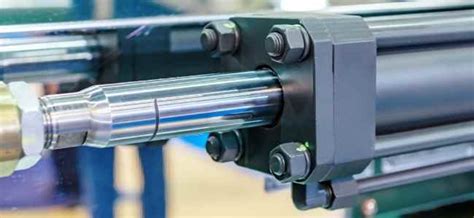Double-Acting Hydraulic Cylinder: Bleeding Techniques Explained
Double-acting hydraulic cylinders are workhorses in many industries, providing powerful linear motion in both directions. However, air trapped within the system can significantly impair performance, leading to sluggish movement, erratic operation, and even damage to components. Proper bleeding is crucial to ensure optimal functionality and longevity. This comprehensive guide details various bleeding techniques for double-acting hydraulic cylinders, addressing common issues and providing troubleshooting advice.
What is Bleeding a Hydraulic Cylinder?
Bleeding a hydraulic cylinder involves removing trapped air from the hydraulic lines and cylinder itself. Air compressibility interferes with the smooth, consistent flow of hydraulic fluid, causing inconsistent performance and potentially damaging seals and other internal components. The goal of bleeding is to create a completely air-free system, allowing for the full and even transmission of hydraulic pressure.
Why is Bleeding Necessary?
Several scenarios necessitate bleeding a double-acting hydraulic cylinder:
- After Installation or Repair: Any time the system is opened, air can enter. New installations and repairs require thorough bleeding.
- After Fluid Changes: Changing hydraulic fluid inevitably introduces air into the system.
- Performance Issues: Sluggish movement, inconsistent force, or unusual noises often indicate trapped air.
- System Leaks: Leaks can introduce air into the system over time, gradually reducing efficiency.
Common Bleeding Techniques for Double-Acting Cylinders
Several methods exist for bleeding double-acting hydraulic cylinders. The optimal technique often depends on the system's complexity and the specific equipment available.
1. Gravity Bleeding
This is the simplest method, suitable for smaller systems with readily accessible bleed screws.
- Steps: Loosen the bleed screw on the cylinder's end caps (one at a time). Allow hydraulic fluid to flow out slowly, observing for air bubbles. Tighten the screw once a steady stream of fluid without bubbles emerges. Repeat for both ends of the cylinder.
2. Pressure Bleeding
This method is more efficient and effective for larger systems or those with longer lines. It uses system pressure to force air out.
- Steps: Connect a pressure gauge to the system. Slowly increase the system pressure. Open the bleed screw on one end of the cylinder. Air and fluid will be expelled. Close the bleed screw when a steady stream of fluid without bubbles appears. Repeat for the opposite end.
3. Pump Bleeding
This method uses a hand pump to introduce fluid into the system and force air out.
- Steps: Attach a hand pump to the system. Pump fluid into the cylinder while slowly opening and closing the bleed screws, cycling through multiple strokes until no more air bubbles are observed.
4. Cycling the Cylinder
This technique involves repeatedly extending and retracting the cylinder while monitoring for air bubbles at the bleed screws. It is often used in conjunction with other bleeding methods.
- Steps: Manually operate or power cycle the cylinder multiple times. Observe the bleed screws for escaping air. Continue cycling until no further air is released.
Troubleshooting Common Bleeding Problems
H2: Why is my cylinder still sluggish after bleeding?
Several reasons might explain persistent sluggishness despite bleeding:
- Insufficient Bleeding: Repeat the bleeding process, ensuring all air is removed. Pay attention to any subtle differences in speed between extension and retraction, indicating air in one of the lines.
- Faulty Bleed Screw: A damaged or improperly sealed bleed screw can impede proper bleeding. Replace if necessary.
- Internal Cylinder Problems: Internal leaks or damaged seals can mimic air-related issues. Inspect the cylinder for damage or consider professional assessment.
- Contaminated Fluid: Dirty hydraulic fluid can hinder efficient operation. Change and filter the fluid as necessary.
H2: I'm seeing minimal fluid flow during bleeding.
This could indicate several issues:
- Clogged Lines or Filters: Check for blockages in the lines and replace filters if necessary.
- Low Fluid Level in the Reservoir: Ensure the hydraulic fluid reservoir is adequately filled.
- Pump Problems: The hydraulic pump might be faulty, preventing sufficient fluid flow.
H2: What type of hydraulic fluid should I use?
The appropriate hydraulic fluid type depends on the cylinder's specifications and operating conditions. Consult the cylinder's manual or the system's documentation for the recommended fluid type and viscosity. Using the incorrect fluid can damage seals and reduce system efficiency.
Conclusion
Proper bleeding is essential for maintaining the optimal performance and longevity of double-acting hydraulic cylinders. Selecting the correct bleeding technique and addressing potential problems promptly prevents costly downtime and ensures the efficient operation of your hydraulic system. Remember, safety should always be paramount when working with hydraulic systems. If unsure about any aspect of the process, seek professional assistance.

